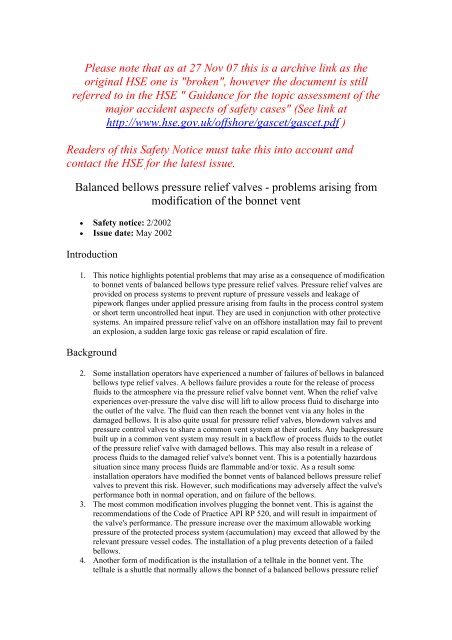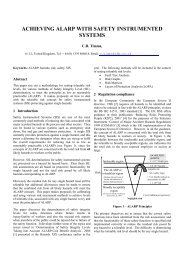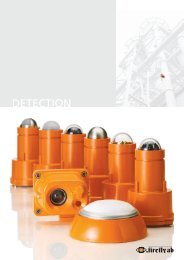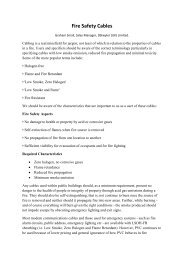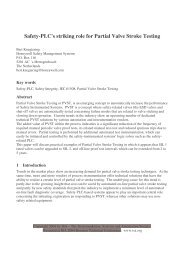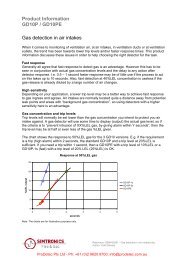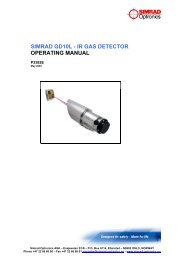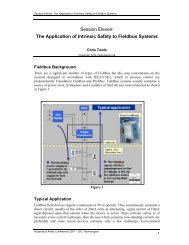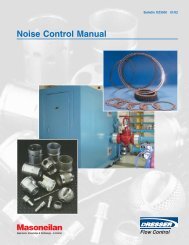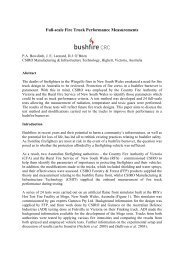Balanced bellows pressure relief valves - ICEWeb
Balanced bellows pressure relief valves - ICEWeb
Balanced bellows pressure relief valves - ICEWeb
You also want an ePaper? Increase the reach of your titles
YUMPU automatically turns print PDFs into web optimized ePapers that Google loves.
Please note that as at 27 Nov 07 this is a archive link as theoriginal HSE one is "broken", however the document is stillreferred to in the HSE " Guidance for the topic assessment of themajor accident aspects of safety cases" (See link athttp://www.hse.gov.uk/offshore/gascet/gascet.pdf )Readers of this Safety Notice must take this into account andcontact the HSE for the latest issue.<strong>Balanced</strong> <strong>bellows</strong> <strong>pressure</strong> <strong>relief</strong> <strong>valves</strong> - problems arising frommodification of the bonnet vent• Safety notice: 2/2002• Issue date: May 2002Introduction1. This notice highlights potential problems that may arise as a consequence of modificationto bonnet vents of balanced <strong>bellows</strong> type <strong>pressure</strong> <strong>relief</strong> <strong>valves</strong>. Pressure <strong>relief</strong> <strong>valves</strong> areprovided on process systems to prevent rupture of <strong>pressure</strong> vessels and leakage ofpipework flanges under applied <strong>pressure</strong> arising from faults in the process control systemor short term uncontrolled heat input. They are used in conjunction with other protectivesystems. An impaired <strong>pressure</strong> <strong>relief</strong> valve on an offshore installation may fail to preventan explosion, a sudden large toxic gas release or rapid escalation of fire.Background2. Some installation operators have experienced a number of failures of <strong>bellows</strong> in balanced<strong>bellows</strong> type <strong>relief</strong> <strong>valves</strong>. A <strong>bellows</strong> failure provides a route for the release of processfluids to the atmosphere via the <strong>pressure</strong> <strong>relief</strong> valve bonnet vent. When the <strong>relief</strong> valveexperiences over-<strong>pressure</strong> the valve disc will lift to allow process fluid to discharge intothe outlet of the valve. The fluid can then reach the bonnet vent via any holes in thedamaged <strong>bellows</strong>. It is also quite usual for <strong>pressure</strong> <strong>relief</strong> <strong>valves</strong>, blowdown <strong>valves</strong> and<strong>pressure</strong> control <strong>valves</strong> to share a common vent system at their outlets. Any back<strong>pressure</strong>built up in a common vent system may result in a backflow of process fluids to the outletof the <strong>pressure</strong> <strong>relief</strong> valve with damaged <strong>bellows</strong>. This may also result in a release ofprocess fluids to the damaged <strong>relief</strong> valve's bonnet vent. This is a potentially hazardoussituation since many process fluids are flammable and/or toxic. As a result someinstallation operators have modified the bonnet vents of balanced <strong>bellows</strong> <strong>pressure</strong> <strong>relief</strong><strong>valves</strong> to prevent this risk. However, such modifications may adversely affect the valve'sperformance both in normal operation, and on failure of the <strong>bellows</strong>.3. The most common modification involves plugging the bonnet vent. This is against therecommendations of the Code of Practice API RP 520, and will result in impairment ofthe valve's performance. The <strong>pressure</strong> increase over the maximum allowable working<strong>pressure</strong> of the protected process system (accumulation) may exceed that allowed by therelevant <strong>pressure</strong> vessel codes. The installation of a plug prevents detection of a failed<strong>bellows</strong>.4. Another form of modification is the installation of a telltale in the bonnet vent. Thetelltale is a shuttle that normally allows the bonnet of a balanced <strong>bellows</strong> <strong>pressure</strong> <strong>relief</strong>
valve (with intact <strong>bellows</strong>) to vent locally to atmosphere on a demand for the <strong>pressure</strong><strong>relief</strong> valve to open. This action does not impair the normal operation of the balanced<strong>bellows</strong> <strong>pressure</strong> <strong>relief</strong> valve and does not result in a local vent of toxic or flammablehydrocarbons. However, in the event of failure of the <strong>bellows</strong> the shuttle is displaced soas to block the bonnet vent. Blockage of the vent will then impair the performance of the<strong>pressure</strong> <strong>relief</strong> valve as described for the plug above, although significantly reducing theamount of toxic or flammable gas released local to the valve. The main advantage of thetelltale over the plug is that monitoring of the telltale post-<strong>pressure</strong> <strong>relief</strong> will indicate<strong>bellows</strong> failure.5. Adopting the above measures while tackling local toxic and flammable hydrocarbonreleases diverts attention away from, and obscures the underlying causes of, thepotentially more significant failure of the <strong>bellows</strong>. When the <strong>pressure</strong> <strong>relief</strong> valve (withthe failed <strong>bellows</strong>) is required to open, potentially critical over<strong>pressure</strong> may occur. This isdue to the <strong>pressure</strong> <strong>relief</strong> valve starting to open at a <strong>pressure</strong> above the required set<strong>pressure</strong>, and also to limitations in flow capacity arising from a decrease in lift of thevalve disc from the valve seat. The force applied to the valve disc by the back <strong>pressure</strong>from the vent or flare system transmitted via the burst <strong>bellows</strong> can cause either of theabove symptoms.Action required6. The following actions must be taken:(a) ImmediateInstallation operators must survey all balanced <strong>bellows</strong> <strong>pressure</strong> <strong>relief</strong> <strong>valves</strong> in serviceon their installations to ascertain the mode of bonnet venting. Where plugs or telltales arein place, the consequences of the blocked bonnet vent on <strong>relief</strong> valve performance mustbe established. Where vessel code over-protection requirements are not met due to ablocked bonnet vent affecting the balanced <strong>bellows</strong> <strong>pressure</strong> <strong>relief</strong> valve, the plug ortelltale must be removed. This must be done safely. Plug or telltale removal mayintroduce the risk of local venting of flammable or toxic gas. Where risk assessmentshows immediate removal of the plug or telltale to be unsafe, the affected system must betaken out of service immediately, unless adequate alternative over-<strong>pressure</strong> protection isavailable.(b) Longer termWhere failure of <strong>bellows</strong> has resulted in the application of plugs or telltales to bonnetvents, the following aspects must be reviewed and remedial measures implemented:i. The root cause of <strong>bellows</strong> failure should be investigated with the <strong>bellows</strong> andvalve manufacturer (chattering, incorrect material specification, incorrect<strong>pressure</strong> rating, incorrect installation, incorrectly specified fatigue life, incorrectdimensional tolerances on <strong>bellows</strong> manufacture etc) to eliminate <strong>bellows</strong> failureso far as is reasonably practicable.ii. If local release of toxic or flammable hydrocarbons cannot be tolerated thenbonnet vents should be piped to a safe location as recommended by API RP 520.iii. If <strong>bellows</strong> failure cannot be eliminated (in circumstances when valveperformance is impaired) then different <strong>pressure</strong> <strong>relief</strong> valve types should beprovided.Relevant legal requirements
7. The main relevant legal requirements are:References• Health and Safety at Work etc Act 1974• The Provision and Use of Work Equipment Regulations 1998 (SI 1998/2306)(PUWER)• The Offshore Installations (Prevention of Fire and Explosion, and EmergencyResponse) Regulations 1995 (SI 1995/743) (PFEER)Sizing, selection, and installation of <strong>pressure</strong> - Relieving devices in refineries, Parts I and IIAPI Recommended Practice 520 American Petroleum Institute 2000, 1994Guidelines for the safe and optimum design of hydrocarbon <strong>pressure</strong> <strong>relief</strong> and blowdownsystems Petroleum Institute 2001 ISBN 0 85293 287 1Further information8. Any queries relating to this notice should be addressed to:Health and Safety ExecutiveHazardous Installations DirectorateOffshore DivisionLord Cullen HouseFraser PlaceAberdeenAB25 3UBTel: 01224 252500Fax: 01224 252629This practice has been brought to the attention of the Health and Safety Executive's HazardousInstallations Directorate's Refinery Issues Group.This guidance is issued by the Health and Safety Executive. Following the guidance is notcompulsory and you are free to take other action. But if you do follow the guidance you willnormally be doing enough to comply with the law. Health and safety inspectors seek to securecompliance with the law and may refer to this guidance as illustrating good practice.


